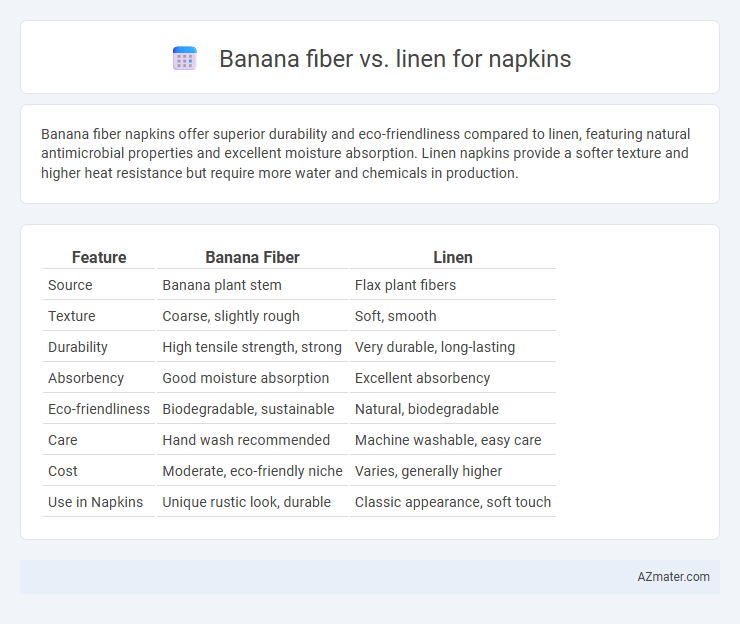Banana fiber napkins offer superior durability and eco-friendliness compared to linen, featuring natural antimicrobial properties and excellent moisture absorption. Linen napkins provide a softer texture and higher heat resistance but require more water and chemicals in production.
Table of Comparison
| Feature | Banana Fiber | Linen |
|---|---|---|
| Source | Banana plant stem | Flax plant fibers |
| Texture | Coarse, slightly rough | Soft, smooth |
| Durability | High tensile strength, strong | Very durable, long-lasting |
| Absorbency | Good moisture absorption | Excellent absorbency |
| Eco-friendliness | Biodegradable, sustainable | Natural, biodegradable |
| Care | Hand wash recommended | Machine washable, easy care |
| Cost | Moderate, eco-friendly niche | Varies, generally higher |
| Use in Napkins | Unique rustic look, durable | Classic appearance, soft touch |
Introduction to Banana Fiber and Linen Napkins
Banana fiber napkins are made from natural banana plant stalks, offering sustainability, durability, and a soft texture ideal for eco-friendly table settings. Linen napkins, crafted from flax fibers, are renowned for their luxurious feel, high absorbency, and long-lasting quality, making them a classic choice in fine dining. Both materials provide biodegradable options, but banana fiber napkins emphasize renewable agricultural byproducts, while linen napkins highlight traditional textile craftsmanship.
Sustainability and Environmental Impact
Banana fiber napkins offer superior sustainability due to their biodegradable nature and the use of agricultural waste, reducing landfill contributions and chemical processing compared to traditional linen. Linen production requires significant water consumption and pesticide use, which can negatively impact ecosystems. Choosing banana fiber supports eco-friendly practices by promoting resource efficiency and lowering the overall carbon footprint in textile manufacturing.
Source and Production Process
Banana fiber is derived from the pseudostems of the banana plant, utilizing agricultural waste through a manual or mechanical extraction process that involves scraping, washing, and drying the fibers. Linen is produced from the flax plant's stalks, where fibers are separated using water retting or dew retting, followed by drying, scutching, and hackling to create a smooth textile fiber. Both fibers offer sustainable alternatives, but banana fiber leverages byproducts from banana cultivation while linen requires the specialized retting process for fiber extraction.
Texture and Softness Comparison
Banana fiber napkins offer a unique texture characterized by a slightly coarse but durable feel, making them ideal for rustic or eco-friendly table settings. Linen napkins, derived from flax fibers, are renowned for their smooth, breathable, and soft texture that improves with each wash, providing a luxurious dining experience. While banana fiber is stronger and more sustainable, linen excels in softness and comfort, making it a preferred choice for upscale napkins.
Durability and Lifespan
Banana fiber napkins offer high durability due to their strong cellulose content, making them resistant to wear and tear over extended use. Linen napkins are also durable, benefiting from flax fibers that provide a natural resistance to abrasion and maintain strength after multiple washes. In terms of lifespan, banana fiber napkins tend to last longer in humid environments, while linen excels with regular laundering without significant degradation.
Absorbency and Performance
Banana fiber napkins exhibit high absorbency due to their natural cellulose content, making them effective in quickly soaking up liquids and maintaining durability after repeated washes. Linen napkins, derived from flax fibers, are renowned for their superior absorbency and quick-drying properties, which enhance stain resistance and long-term performance. Both fibers offer excellent durability, but linen's texture and strength provide a slightly better performance in resistance to wear and repeated use compared to banana fiber.
Style and Aesthetic Appeal
Banana fiber napkins offer a unique, rustic texture with natural variations that create an earthy, organic aesthetic ideal for eco-conscious and bohemian table settings. Linen napkins provide a smooth, refined finish with a subtle sheen, giving a timeless, elegant look perfect for formal dining occasions. Both fibers enhance style distinctively, with banana fiber emphasizing artisanal charm and linen delivering classic sophistication.
Cost and Market Availability
Banana fiber napkins are generally more affordable than linen due to lower raw material and production costs, making them a budget-friendly option for eco-conscious consumers. Linen napkins, derived from flax plants, often come with a higher price point reflecting their durability, luxurious feel, and established market demand. While linen is widely available across various retail outlets, banana fiber napkins are less common but gaining traction in niche sustainable textile markets.
Care and Maintenance Guidelines
Banana fiber napkins require gentle hand washing with mild detergent to preserve their natural texture and avoid shrinkage, while linen napkins are more durable and can be machine washed on a gentle cycle using cold water. Both fibers benefit from air drying to maintain fabric integrity and prevent damage from high heat, but linen may be ironed at a higher temperature for a crisp finish. Proper storage in a dry environment protects banana fiber napkins from moisture-related mildew, whereas linen is less susceptible to such issues due to its stronger fibers.
Which Fabric is Better for Napkins?
Banana fiber offers superior absorbency and natural antimicrobial properties, making it highly effective for napkins that require durability and hygiene. Linen, derived from flax, provides excellent softness, long-lasting strength, and a refined texture ideal for elegant dining settings. Selecting between banana fiber and linen depends on the desired combination of eco-friendliness, durability, and tactile experience for napkin use.

Infographic: Banana fiber vs Linen for Napkin
 azmater.com
azmater.com